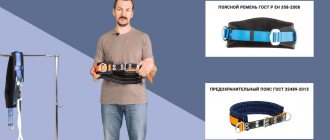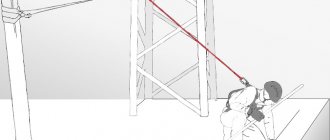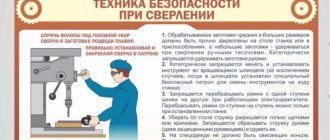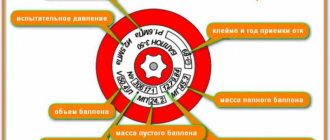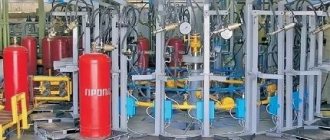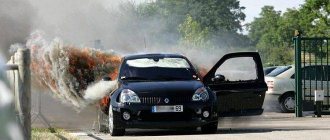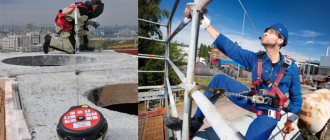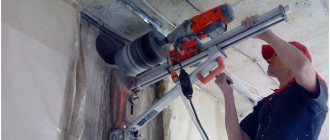To work at height, special reliable means are needed to help a person climb to the top. Moreover, such tools must be reliable and easy to use. There are two ways to climb to heights: aerial platform and fitter's claws
Electrician's claws
The first method is more expensive: it requires the placement of equipment, financial investments in fuels and lubricants, and maintenance of the aerial platform. Installer's claws are a practical method that does not require additional investment for performing electrical installation work on overhead line supports.
The disadvantage of this method is that production is performed by one worker. If there is a need for collective work, this method is not suitable for this type of activity.
Types of monter claws
Depending on the design, monter claws are divided into sickle claws and monter claws.
Sickle-shaped claws are divided into subgroups: KM-1, KM-2, KM-3 and others. Such claws are sickle-shaped and have a certain size. They are used to lift onto wooden supports during electrical installation work on overhead lines. Monter's manholes also have several types: LU-1, LU-2 and others. The main differences are: the ability to climb onto reinforced concrete supports of rectangular and trapezoidal shape, as well as the ability to adjust the size.
Electrician's manholes, their types and application
Depending on their purpose, concrete power line supports can have different cross-sectional shapes:
- centrifuged (round);
- rectangular;
- trapezoidal;
- polygonal.
Types of electrical supports for power lines
Each type of support (see photo) has its own design of devices for safe and convenient maintenance of lighting elements.
Classification and purpose of the tool
Installation manholes, regardless of the type of work performed, must be equipped as follows:
- sickle (hook);
- thorns;
- step;
- leather straps to firmly secure the fitter's feet.
Electrical installation manholes
The sickle is the working part of the device, made of pipes of the required diameter with fastening elements (spikes) attached to it. The footrest looks like a flat metal structure. The installer's foot is secured using durable leather straps with clamps attached to the body of the footrest.
All parts of the devices are designed for safe operation within temperatures from -40 to +50°C, and with proper use they retain their positive performance characteristics for 36 months.
Depending on the type of work and the shape of the lighting stand, installation manholes for concrete have several varieties:
- KLM (1–2) - claws of Laza montera. They are used for servicing trapezoidal and rectangular lighting poles. Hook opening 160–180 mm. The weight of the sets is respectively 3.7–5.4 kg.
Manholes KLM-1
- LMC - manholes on concrete for climbing and descending round or multifaceted pillars. The opening of the working part is 305 mm. Set weight 4.20 kg. Permissible force 180 kgf/unit.
Device for centrifuged supports
- LU - universal manholes with the ability to adjust the gripper opening. Grip opening 175–190 mm. The structure is adjusted using two bolts located on the device body. Product weight 5.8 kg.
LU-2
Necessary conditions for safe use of devices
The instructions for performing electrical installation work with your own hands provide for the following conditions:
- An electrician performing work at height must undergo training at a specialized center and obtain the necessary certificate allowing independent work.
- Before starting work, you must carefully inspect the device and make sure that all connections are secure, including the condition of the belts for securing the tool.
- The fixing belts must be made of two-layer fat-impregnated leather for installation work in any climatic conditions. The required belt thickness is 3 mm or more. The belt buckle must be made with a protective and decorative coating.
- Metal elements of manholes should not have cracks, dents, breaks or sharp burrs. Welding seams of connections must be smooth without visible defects. Working spikes should not be beveled and have the required geometric shape.
- The spikes of the device must move freely in the horizontal plane, but at the same time, the vertical play should not exceed 1 mm.
Safety belt
The video explains the rules of claw climbing and climbing.
Legislative framework of the Russian Federation
Free consultation
Federal legislation
- home
- “INDUSTRY RULES FOR OCCUPATIONAL SAFETY DURING MAINTENANCE AND REPAIR OF SIGNALING, CENTRALIZATION AND INTERLOCKING DEVICES ON FEDERAL RAILWAY TRANSPORT. POT RO-13153-TSSh-877-02" (approved by the Ministry of Railways of the Russian Federation on February 19, 2002)
| Name of document | “INDUSTRY RULES FOR OCCUPATIONAL SAFETY DURING MAINTENANCE AND REPAIR OF SIGNALING, CENTRALIZATION AND INTERLOCKING DEVICES ON FEDERAL RAILWAY TRANSPORT. POT RO-13153-TSSh-877-02" (approved by the Ministry of Railways of the Russian Federation on February 19, 2002) |
| Document type | rules |
| Receiving authority | MPS RF |
| Document Number | POT RO-13153-TSSh-877-02 |
| Acceptance date | 01.01.1970 |
| Revision date | 19.02.2002 |
| Date of registration with the Ministry of Justice | 01.01.1970 |
| Status | valid |
| Publication |
|
| Navigator | Notes |
Monter's claws and manholes
4.2.24. Assembly claws must comply with the requirements of TU 34-09-10147-88. The claws are designed to work on wooden and wooden with reinforced concrete stepson supports of power transmission and communication lines, on reinforced concrete supports of overhead power lines (OHT) 0.4 - 10 and 35 kV, as well as on cylindrical reinforced concrete supports with a diameter of 250 mm of 10 kV overhead power lines.
4.2.25. Metal parts of claws and manholes should not have dents, cracks, breaks, burrs, or sharp edges. Welding areas must be level, smooth, without cavities or other defects.
Removable tenons must not be knocked down or beveled.
4.2.26. By order of the workshop or area in the organization, persons responsible for the good condition of the claws and manholes must be appointed.
4.2.27. Claws and manholes must withstand a static load of 1765 N (180 kgf) without permanent deformation.
4.2.28. The service life of claws and manholes (except for spikes) is 5 years.
On the foot of the claw, the hole should be applied:
a) manufacturer's trademark;
c) date of manufacture.
4.2.29. The use of claws and manholes that have blunted or broken spikes is not permitted.
Safety Precautions - Inspection and Testing
When using this device, specialists working at height must have additional equipment in their arsenal in the form of a protective helmet, which will protect against an accidental blow, as well as a safety lanyard, which will help to avoid serious consequences.
Straps for fastenings should also be available. The design of the belts must guarantee convenience and reliability in use, therefore their thickness must be at least 3 mm. These devices are made of two-layer leather, which is impregnated with fat. Each access hole must be marked with the date of the next inspection.
Before climbing to a height, you should thoroughly inspect the claws and check the test date. In addition, it is necessary to ensure the reliability of the welds, the integrity of the spikes, and the serviceability of the worm mechanism.
The metal elements of the device must not contain dents, breaks, sharp edges, cracks, or burrs. The spikes must not be damaged, beveled or knocked down. It is prohibited to use claws whose spines are blunt or absent altogether.
These devices are tested once every six months with a statistical load.
The device must be loaded for five minutes, with the load passing through the center point of the footrest. Before testing, a visual inspection is carried out to ensure that all parts are fastened and that there is no damage to the belt firmware. The fixing nut must be tightened with a locking ring.
In addition, the correct sharpening of the spikes is checked. The tests are carried out on a wooden support, the diameter of which corresponds to the numbering of the claw. After testing on the claws and manholes, there should be no deformation of the elements, damage to the welds, or breakage of the belts. Then measurements are taken, which are compared with previous values and recorded in a special journal.
If, after loading, defects are revealed, then such devices must be repaired; spikes and other damaged components are replaced. After troubleshooting, the device is again subjected to load.
Construction of lineman's claws
Manholes and similar structures consist of steel parts that are arranged in a semicircle or perpendicular, as well as spikes that allow them to cling to the surface of the pole. They are attached to a special foot platform, which has straps to secure the worker's feet. To keep it in an upright position, the kit includes slings and a harness to prevent a person from falling if the wire slips or falls. However, only one worker can lift such a device. If you need to lift two or more workers, you must use the services of a lift truck. Next, we will consider the main types of such devices depending on their purpose.
Design and principle of operation
The simplest manholes for concrete supports consist of 2 elements for attaching to shoes, each of which consists of the following main components:
- Oval foot support with transverse reinforcements;
- 2 straps holding the foot on the platform;
- “Sickle” is a rectangular grip with 4 conical spikes attached at an angle of approximately 600 to the supporting platform.
Climbing onto a reinforced concrete pole using a similar device occurs as follows:
- The electrician securely fixes the manholes on his shoes using belts;
- Approaching the pillar, he grabs it with the grips of each of the elements of the claws;
- The electrician climbs the pole, thanks to the fact that the claw grips, which he alternately rearranges in the vertical plane, located at an angle to the supporting platforms, bite into the concrete with their spikes and prevent slipping.
Using a similar principle, electrical claws designed for this type of support help you climb onto a wooden pole. Their only differences from the crampons used for concrete pillars are the semicircular shape of the grips and softer spikes.
What materials are used for claws?
Today there are few power poles made of wood left. And this is not surprising, given that they have a more attractive alternative in the form of reinforced concrete structures, which have increased strength and a long service life.
This innovation forced the modernization of manholes for servicing power lines. The design now features special carbide inserts , which reduce the risk of slipping and increase tool life. In appearance, these elements look like cat paws. In the vast majority of cases, high-quality high-strength steel is used to create manholes. At the same time, to give additional strength to the metal, an anti-corrosion coating is applied to it.
As a result, this device not only becomes harder, but also gains greater durability. The belts used have a multi-layer structure, and the material for them is yuft and rawhide. For greater reliability, the belts are stitched with heavy-duty nylon threads.
What it is?
Claws or claws are special devices for lifting a worker onto a power line pole. They are fixed on a person’s legs and make it possible to gain a foothold on a support and stay in one position for the required amount of time. The structure of the manholes will be improved to increase the reliability of the equipment and the speed of climbing to the top. There are three groups of such devices:
It is convenient to climb the round pillars using universal equipment.
- Lazy. Designed for lifting reinforced concrete structures of round and trapezoidal shape in section.
- Universal hooks. The installation tools are suitable for round pillars made of concrete or wood. The latter have lost their relevance.
- Claw-holes. They differ in structure. Equipped with a specific control solution, especially effective in relation to trapezoidal reinforced concrete supports.
The latter devices are used more often than other types, because their specificity allows this device to be used to work with all types of standard supports. The use of manholes is permitted if this possibility is confirmed by accompanying documents. Each company specializing in electrical installation has its own set of tools for servicing power lines.
Claw-holes for concrete, metal, round and polyhedral supports of overhead lines and communications
Professional claw-claws are equipped with a convenient screw mechanism for adjusting the width of the aluminum footrest base with rubber pads and tanned chrome straps.
Reliable adhesion to the reinforced concrete support is provided by profiled, arched, steel paws covered with rubber, anti-slip hoses.
Carabelli Srl's manhole claws are made from high-strength materials, thanks to which they do not bend under weight and do not slide off the poles.
Adjustable claws model 3005
| Dimensions | Ø SUPPORT | Weight, kg | |
| min. Ø, cm | Max. Ø, cm | ||
| 1 | 9 | 22 | 6,5 |
| 2 | 14 | 27 | 6,7 |
| 3 | 16 | 33 | 7,1 |
| 3S | 14 | 30 | 7,1 |
| 4 | 26 | 40 | 7,4 |
| 5 | 28 | 46 | 7,7 |
Non-adjustable claws model 3020
| Dimensions | Ø SUPPORT | Weight, kg | |
| min. Ø, cm | Max. Ø, cm | ||
| 1 | 8 | 16 | 4,2 |
| 2 | 12 | 20 | 4,3 |
| 3 | 16 | 24 | 4,5 |
| 4 | 18 | 28 | 4,7 |
| 5 | 22 | 34 | 5,1 |
carabelli-cis.com
Installer's claws for working on wooden supports
The design capabilities of assembler's claws for wooden supports, commercially produced in accordance with GOST 14331-77, are presented below:
- Type KM-1 – recommended support diameter 140...245 mm, throat 245±10 mm;
- Type KM-2 – recommended support diameter 220...315 mm, throat 315±10 mm;
- Type KM-3 - recommended support diameter 310...415 mm, throat 415±10 mm.
The platform of the KM series claws is stamped, with perforated holes, which makes it possible to increase the reliability of contact of the foot with the surface, while simultaneously reducing the weight of the platform. After stamping, the platform is hardened to a hardness of HRC 38…42. On one of the side surfaces of each platform there are ears for attaching steel arches. Along the remaining edges of the platform there are low sides, the presence of which prevents the electrician’s foot from accidentally slipping. To strengthen it during manufacturing, stiffening ribs are formed on the rear surface of the platform.
[xyz-ihs snippet=”seredina”] The fixing part of the arc rotates freely in the ears, ensuring the fixation of the spikes along the support at the time the line operator is lifted. The permissible play should be no higher than ±15º.
The quick-wearing part of repairman's claws are the spikes, despite the fact that their initial hardness after hardening is 45...50 HRC. For claws on wooden supports, spikes are always made with conical tips. Experiencing significant frictional stress, steel spikes become dull and deformed over time. The durability of carbide studs is much higher, but they are sensitive to impacts and bending loads. Replacing the studs is not difficult, since their fastening part is threaded. The rear part of the platform is also equipped with spikes of a similar design.
The leg of the working person is attached to the arch of the claw using straps. In order to ensure elasticity, their upper part is made of yuft, and the lower part is made of rawhide impregnated with animal fat. The stitching of the belt elements is carried out with nylon threads, and the thickness of the belt and the diameter of the threads are calculated for a load of at least 140...160 kg.
Analysis
| № | Question | Result |
| 1 | Which categories of workers belong to group 2 regarding safety of work at height? Correct answer: Foreman, foremen, internship supervisors, as well as workers appointed as responsible performers of work at height under work permits for work at height. Your answer: Comment: | |
| 2 | Who re-admits subsequent shifts to a prepared workplace? Correct answer: Responsible work manager. Your answer: Comment: | |
| 3 | Subject to the rules of operation and storage, the shelf life of protective equipment made of synthetic materials (PPE against falls from a height, having non-metallic elements) should not exceed ... Correct answer: 5 years. Your answer: Comment: | |
| 4 | Is it allowed to work with several workers simultaneously, the work of one worker on top of another vertically? Correct answer: One worker working on top of another vertically is not allowed. Your answer: Comment: | |
| 5 | What group of workers should have when performing tree pruning (felling) work? Correct answer: Must have group 2 and higher. Your answer: Comment: | |
| 6 | What marking group should steel ropes be? Correct answer: Not lower than 1558 MPa (160 kgf/sq. mm). Your answer: Comment: | |
| 7 | What is prohibited when working with an extension ladder or stepladders? Correct answer: Work from the top two steps of stepladders that do not have railings or stops. More than one person should be on the steps of a ladder or stepladder. Lift and lower loads on a ladder and leave tools on it. Your answer: Comment: | |
| 8 | What should be applied to the foot of the claw, manhole? Correct answer: Manufacturer's trademark. Number. Date of manufacture. Your answer: Comment: | |
| 9 | What should every lifting mechanism and device have? Correct answer: Documentation provided for by the relevant technical regulations, standards or technical specifications for manufacturing. Your answer: Comment: | |
| 10 | What should the load (each part of the load) have during the process of lifting, moving, lowering? Correct answer: Reliable slinging. Reliable support. Your answer: Comment: |
Repeat
Care, storage, service life
Manholes are a universal device; they can be used in almost any climate zone with a temperature range from minus 40 to 50 degrees above zero. This means that work on power lines can be carried out both in the northern regions and in hot and sultry conditions.
The service life is indicated by the manufacturer. Time is counted from the moment the products are put into operation. No later than a year later, such a tool must be removed and recycled or disposed of. The maximum operating life of manholes is 60 months. Components are changed during operation as needed. The warranty period is usually 1 year from the moment the product is put into operation.
Store the device in a temperature range from minus 20 to 30 degrees above zero. It is unacceptable to store manholes in a room with an open roof; precipitation will leave a sharply negative mark on the quality of the devices.
Monter's manholes do not require special care. After use, they must be cleaned, any remaining dirt must be removed with a rag and stored away. Do not wash under water or wipe with wet material.
In conclusion of our article, we suggest watching a video of how assembly manholes are made and how to correctly lift using them:
Hand tools
4.3.1. Hand tools must meet the following requirements:
wooden handles must be made of hard and tough wood, smoothly processed and securely fastened;
the working part of the tool should not have cracks, burrs or chips.
4.3.2. Hand tools must be inspected by a senior electrician at least once a quarter, as well as by the employee using the tool immediately before use. The faulty instrument must be removed.
4.3.3. Bench hammers must be made in accordance with GOST 2310 from steel grades 50.40X or U7. The working ends of the hammers must have a hardness of 50.5-57 HRC at 1/5 of the length at both ends.
4.3.4. The use of files, scrapers, screwdrivers without handles and bandage rings on them or with poorly secured handles is not allowed.
4.3.5. The handles (handles) of shovels must be smooth and firmly fixed in the holders.
4.3.6. The crowbars and mountings used during work must be smooth, without burrs, cracks or hardening.
4.3.7. Chisels, punches, bits must be made in accordance with GOST 7211, GOST 7213, GOST 7214 from steel grades U7, U7A, U8 or U8A. Chisels and bits should not have cracks, hairs, knocked down or beveled ends. The cutting edge of the chisels is hardened to 0.3 - 0.5 of the total length and subjected to tempering. The working part of beards, notches, cores, etc. hardened to a length of 15-25 mm. The back of the instruments must be smooth, without cracks, burrs or hardening. There should be no damage to the working end.
4.3.8. The shape and dimensions of the wrenches must comply with the requirements of GOST 6424, GOST 2838 and GOST 2839.
Single-sided wrenches must comply with the requirements of GOST 2841.
The jaws of the keys must be strictly parallel and not rolled up. The dimensions of the wrench mouth must correspond to the dimensions of the nuts and bolt heads. The dimensions of the wrench mouth should not exceed the dimensions of the nuts and bolts by more than 5%.
4.3.9. The handles of pliers and hand scissors should be smooth, without dents, nicks or burrs. There should be a stop on the inside to prevent pinching of the fingers.
4.3.10. The vice must be manufactured in accordance with GOST 4045, firmly attached to the workbench so that its jaws are at the level of the worker’s elbow. If necessary, wooden ladders should be installed along the entire length of the working area. The distance between the axes of the vice must be at least 1 m. The vice must ensure reliable clamping of the product.
The jaws of the vice must be parallel, have a notch and provide reliable clamping of the workpiece.
4.3.11. Before use, hand-held plumbing tools must be inspected in order to remove and repair faulty ones.
4.3.12. Tools with insulating handles (pliers, pliers, side and end cutters, screwdrivers) must:
have dielectric covers or coatings without damage (delamination, swelling, cracks) and fit tightly to the handles;
stored indoors, without touching heating radiators and protected from sunlight, moisture, and aggressive substances.
4.3.13. Testing of tools with insulating handles must be carried out in accordance with the requirements of the Rules for the Application and Testing of Protective Equipment Used in Electrical Installations and technical requirements for them.
Automatic installation of hyphens The procedure for preparing a text document must comply with the requirements of state 105-95 ESKD. “General requirements for text documents”... Instructions on labor protection General requirements for labor protection are set out in the instructions "General requirements for labor protection for workers engaged in logging and silviculture... Instructions on labor protection for the driver of pneumatic conveying units General requirements for labor protection are set out in the Instructions General labor protection requirements I. General requirements General provisions Approve the attached Inter-industry rules for labor protection during the operation of water supply and sewerage facilities I. General requirements General provisions In accordance with the All-Russian Construction Catalog, these Inter-industry rules have been assigned the code pot rm-025-2002 2. General requirements safety This Instruction regulates the basic safety requirements when performing plumbing maintenance work... 1 Scope This standard establishes the classification of physical education, health and sports services, general requirements, safety requirements... of the Russian Federation “Occupational safety in construction. Part General requirements” On the adoption of building codes and regulations of the Russian Federation “Labor safety in construction. Part General Requirements” Requirements for testing laboratories of the safety subsystem in the energy sector SDA-34 This document establishes general requirements for testing laboratories (electrical laboratories and heat engineering laboratories... Instructions on fire safety measures in preschools general requirements This instructions establishes the basic safety requirements for a preschool educational institution (hereinafter dou) in accordance with... Plan: Concept and classification of documents. General rules for registration... Types of management documentation. General requirements for the preparation and execution of documents Interstate standard GOST 1-2003 “System of standards for information,... System of standards for information, library and publishing. Bibliographic record. Bibliographic description. General... “GOST R 51185-2014. National standard of the Russian Federation. Tourist... GOST R 51185-2014. National standard of the Russian Federation. Tourist services. Accommodation facilities. General requirements Interstate standard system of standards for information, library... GOST 1-84. System of standards on information, librarianship and publishing. Bibliographic description of the document. General requirements... Provisions relating to transport equipment and transport... The electronic text of the document was prepared by Stack LLC. 185005, Republic of Karelia Instructions on fire safety measures in kindergarten general requirements General provisions of the State Budgetary Institution for Kindergarten and is mandatory for all officials and individuals. Persons guilty of violating the General Object...
Structure
Monter's manholes (claws) are a design of two main parts:
The hook has the shape of a trapezoid or rectangle. For strong adhesion to the support, it is equipped with teeth and self-adjusting spikes. The belts are made of genuine leather, sewn in two layers. The total weight of the structure is from three to five kilograms.
The laz works using momentum: different levels of spikes allow the hooks to be more firmly fixed under the influence of a person’s weight. The more weight, the better the grip. The gravity of the body, whatever it may be, will create the necessary moment of momentum, allowing you to maintain the required mass.
Selection rules
To make the right choice of claws, you need to have some knowledge in this area. When choosing a device, you should pay attention to the following nuances:
Product price. In this case, it is worth remembering that cheaper versions of the claws may use insufficiently high-quality metal, as a result of which the device will be unreliable and dangerous. Focus on medium or high price, which guarantees quality.
Manufacturer. As you know, it is better to trust proven and well-known manufacturers.
Quality. Products must comply with current GOST or TU and have quality certificates. Upon external inspection, no defects or unevenness of the seams should be noticeable. The thickness of the belts must be at least 0.3 mm, the stitches must be even and securely fixed.
Care, storage, service life
The effectiveness of the claws is that they can be used at any temperature from -40 to +50 degrees. This device can be used in work both in hot areas and in the far north.
The invention is used only for a limited period. With constant use, the claws are used for no more than a year. The maximum service life is 5 years. In addition, it is recommended to periodically replace components. When using this method of lifting onto air supports, you must strictly follow the operating rules specified in the instructions.
The best storage temperature for the device is considered to be from -20 to +30 degrees. This will not interfere with its effectiveness in use. In order not to spoil the functional properties, repair claws are stored in a dry, well-ventilated area. Also during storage it is necessary to avoid sunlight.
In addition, to preserve the manholes, it is necessary to clean them from dirt and wipe them dry after each use. If the claws are wet, they must be dried and taken to a warehouse or other room that maintains the required temperature for storage and ventilation.
If one of the device components breaks down, its further operation is strictly prohibited. Repairs should only be carried out by a specialist in the field.
Rules for using claws
All electrical access points must meet the following criteria:
- Compliance with established standards;
- Availability of manufacturer's markings;
- Technical data including date of manufacture and serial number;
- Regular safety testing using static load.
Before lifting, the claws must be checked by the employee together with the supervisor. Additionally, there is a belt for support. During the inspection, the date of the test, the serviceability of all components and parts, the condition of the spurs and seams of the clamp, the strength of all fasteners and the presence of nut plate locks with cotter pins are recorded.
Metal elements must be in perfect condition, without various defects, including dents, chips and sharp edges. The welding joints must be level, this will allow you to move safely on concrete. You also need to additionally check the technical condition of the following elements:
https://youtube.com/watch?v=CnqJBVgiDI8
- Fixation of the C-shaped part with the footrest;
- Various types of carvings;
- Variable plates;
- Strength of fastening of locking type nuts.
Then you need to inspect the structure. Damaged claws cannot be used for further use. The solution and the rise of the cat are measured before and after the test and recorded with special documentation. Persons over 18 years of age are allowed to use devices to move along poles. To do this, they must have the following documents with them:
- Permission to carry out steeplejack work;
- Certificate of completion of a medical examination;
- Admission to work or the presence of a supervising experienced specialist, if this is the employee’s first year in the position.
Only after all necessary procedures and checks have been carried out can work be carried out on electrical poles using electrical installation equipment, including claws and concrete manholes.
Claws for climbing poles are indispensable elements that allow the worker to carry out installation and save on operating costs. However, before starting action, a thorough check must be made to ensure that the equipment is in good working order, as well as whether the employee has all the necessary documents and confirmation of his age. Otherwise, carrying out such work will be unsafe for both the installer and his superiors, since you can receive quite serious punishment. Remember this before starting any electrical installation work!
How claws and manholes are tested at the LabEletro laboratory
Visual inspection
Checking claws and manholes begins with a thorough inspection and identification of visible damage to components and parts. First of all, attention is paid to the condition of the welds. The integrity of the studs, inserts, the reliability of the firmware of the belts and the safety of the buckles are also checked.
Mechanical tests
To confirm suitability, static load test is carried out on the assembly manholes The claw or hole is installed in the working position on the beam. By means of a cable, one end fixed to the PPE fastening belt, and the other connected to the dynamometer, a breaking force is created. The test is considered passed if the claws and manholes withstand a load of 180 kg/s for 5 minutes without damage to the welds, deformation of the buckle or tears of the belts.
Product selection criteria
Smooth-haired cats lead a very active lifestyle and love to climb trees and claw at each other. A sharpener for them can be made from thin twigs that are equipped with bark. Fluffy cats are less active and more phlegmatic. They are not characterized by high activity and have no desire to climb branches. For such cats, you need to make a stable sharpener with a resting area.
Do not place the product near your sleeping area. Home safety is important for a cat , and he will not tolerate unnecessary objects near the house. This arrangement will cause anxiety in the cat; most likely, he will move away from such a complex.
The exception is cats of wild breeds. A Siamese, Bengal, or Abyssinian cat will be quite happy with a complex in which there will be a house and a sharpener. In nature, they live in trees, and therefore such close proximity of two favorite places is the norm for them. Experts advise making a bench and inspection platform on a pole. It must be branched enough to allow the animal to move around the scratching post. If it is not possible to buy a wooden pole, then you can build such a tree from cardboard tubes.
How to use monter's claws
To work at height, special reliable means are needed to help a person climb to the top. Moreover, such tools must be reliable and easy to use.
There are two ways to climb to a height: using an aerial platform and using fitter's claws.
The first method is more expensive: it requires the placement of equipment, financial investments in fuels and lubricants, and maintenance of the aerial platform. Installer's claws are a practical method that does not require additional investment for performing electrical installation work on overhead line supports.
The disadvantage of this method is that production is performed by one worker. If there is a need for collective work, this method is not suitable for this type of activity.
Review of brands and manufacturers
The following companies deserve mention and are trusted by consumers:
- CJSC "Potential";
- electrical engineering plant KVT;
- production association "ZMO".
(Nizhny Novgorod)
Installer's claws No. 2, manufactured (Nizhny Novgorod) are used for electrical installation work on wooden vertical supports or wooden poles with reinforced concrete attachments for overhead power lines. The opening of the device is 315 (±10) mm, the lift is 160 (±10) mm.
- The diameter of the supports allowed for use is 220-315 mm.
- The cost of the device is about 2-2.5 thousand rubles.
- The main characteristics of claws No. 2 2 are presented in the table.
Products of the KVT enterprise (KVT electrical plant)
The KVT enterprise produces the popular and sought-after model of KLM claws in two versions - KLM-1 and KLM-2. Both options are used for work on trapezoidal overhead line supports.
- KLM-1 ensure safe operation on columnar supports of types SV110-1a and SV110-2a. The claw length is 168±4 mm, weight is 5.3 kg. The price of KLM-1 claws, depending on the region, is 2.2-2.8 thousand rubles.
- Claw-holes KLM-2 weighing 5.4 kg and opening 190±4 mm are widely used for posts SV105-3.6 and SV105-5. The cost of the device is approximately 3.5 thousand rubles.
Comparative characteristics of the KLM-1 and KLM-2 claws are presented in the table.
Production Association "Installation Equipment Plant"
The production association "Installation Equipment Plant" boasts two popular models. KM-1 claws are widely used for work on wooden and wooden with reinforced concrete inserts power transmission line supports, on communication line poles with a circumference of 140-245 mm.
- The forged sickle and spikes are made from reliable 40X steel and are supplied with leather straps. The device's opening is 245±10 mm with a fairly low mass of 3.6 kg. The cost of KM-1 ranges from 2400 to 2900 rubles.
- Universal switchgear manholes are used on supports of trapezoidal cross-section of overhead lines of the SV110-1a, SV95-1(2a), SV105-5 and SV105-3.6 brands. The manhole has an adjustable opening in the range from 168 to 190 mm. Reliable adhesion to the surface of the supports is ensured by carbide spikes. Supplied with leather straps.
- The weight of the product is approximately 5 kg.
- KRU manholes can be purchased for 2900-3700 rubles.
Comparative characteristics of KM-1 claws and KRU manholes are presented in the table.
One-day
Acuvue 1-Day TruEye (30 lenses)
pros
- convenient packaging
- not felt before the eyes
Minuses
- price
- not suitable for everyone
From 1500 ₽
This option is a godsend for those who want natural and natural contact between lenses and eyes, without inflammation and redness. The silicone hydrogel base allows oxygen to pass through, so the visual organs are able to “breathe”. HYDRACLEAR® technology is responsible for constant hydration and ultra-smoothness of the lenses. In addition, 1-DAY ACUVUE TRUEYE has the highest level of protection against dangerous UV rays among all ophthalmic products. Indispensable for travel: in the evening the used pair is disposed of, and in the morning a new one is put on.
Dailies (Alcon) Total1 (90 lenses)
pros
- wear all day without discomfort
- eyes don't dry
Minuses
- high price
From 4490 ₽
Very comfortable one-day stays. Particularly good in the summer under sunglasses, during allergy season, and convenient on vacation. The lenses have received many rave reviews.
Electrician's manholes for electrical installation on concrete supports
Working at height is always accompanied by great risk, so you need to use only proven equipment and follow all safety standards. There are many devices and mechanisms for lifting a specialist onto a concrete or wooden power line pole, but the fastest of them are considered to be claws made specifically for climbing poles, which can be factory-made or home-made. This article discusses questions about the use of these items, as well as types of claws and their purpose.
Claws for lineman
Types of claws of monter KM
Based on the classification according to their purpose, electrical installation claws are of the following types:
- Crescent-shaped products have the shape of a semicircle, with a flat platform at the base. A person inserts his feet into this plane and secures them with special straps that fasten the toes and heels around the foot. These products are also called tree climbing claws, since they are usually used for climbing wooden supports with a circular cross-section;
Crescent holes
- Laza monter claws or KLM 2 - these parts are fundamentally different from the sickle-shaped ones in their shape. Here, the elements of the hook have the form of straight sections with protrusions that tightly compress the plane of the pillar, and due to the pressure of the installer’s weight on the base of the platform, the entire structure is securely fixed to the support. This tool is universal and suitable for use on any type of poles, both wooden and reinforced concrete, since their size can be adjusted by moving the bar forward. Concrete supports come in various shapes: trapezoidal, rectangular, hexagonal or conical, so when choosing manholes you need to size them according to the cross-section.
Universal manholes
Despite so many types of supports for electrical cables, there are only two types of claws, so if it is not possible to use one of the proposed options, then you need to use a special aerial platform equipped with an installer’s cradle. This machine is capable of lifting several people to the work site at once; its cost, as well as the time it takes to complete the work, are high. Concrete lineman's manholes are an excellent alternative to aerial platforms, and they also allow you to eliminate an accident on the line in a much shorter period of time.
Areas of application of KLM2
The main purpose of this product is to quickly deliver a worker to the top of a power line support, for example, during installation and cable laying, as well as for urgent repairs. It is much easier and faster to deliver a repairman upstairs using claws, since it is not always possible to fit special transport, for example, in mountainous areas or in dense urban areas.
Automotive tower
Tree climbers are often used on poles with a circular cross-section to replace lighting lamps on the streets, since there are a lot of lamps, and it is constantly too expensive to transport special vehicles, so it is easier for the worker to climb the climbers himself and make repairs.
The set of claws for an electrician includes two feet, as well as a special waist belt, which is looped around the support and fastened to the belt with a carabiner. This eliminates the possibility of a worker deviating from the pole and disrupting the platform’s grip. Installer's claws of the name km 1 are freely inserted and removed from the support profile with a simple movement of the foot, the coupling is strengthened by the presence of spikes on the U-shaped frame, when pressure is applied to the platform by the weight of the installer, the pins are stuck into the concrete and increase contact with the surface.
Rules for using claws, safety precautions
Manufacturers of such products clearly regulate the standards for the use of claws and issue special instructions that must be followed during work. According to this document, for proper operation of installation holes you need:
- Coordinate the action plan and work out in detail all actions on the ground. The installer must have all permits for work and undergo safety training;
- Line repairs should be carried out with the power off, using insulating gloves and other rubber products;
- Installer's manholes are used only for working on the supports for which they are intended; it is prohibited to use claws of an unsuitable shape, since the contact with the surface will be inaccurate;
- Before using electrician's claws, you must check the last test date and all welds for corrosion and cracks. Bolted connections also need to be carefully inspected and tightened. Destruction of the platform at height can cause the installer to fall, which will lead to injury;
- According to the manufacturer's standards, once every six months the claws must undergo technical tests, as a result of which a report is drawn up indicating the date of the next test;
- It is important to always use the safety belt that comes with the climbs. It is prohibited to climb onto the support without this device or with a damaged mechanism;
- Straps and buckles securing the electrician's foot should also be checked before each lift to ensure that the skin is not pulled or torn. If these defects are found, then the use of claws is not recommended;
- It is strictly forbidden to climb on concrete supports along which the grounding line is laid, since the spikes can stick into the cable and pierce through it.
These rules are the basic safety precautions when working at height using electrical claws, so breaking them can lead to negative consequences. It is recommended to use only factory-made manholes, since home-made products do not undergo inspections and tests, as well as periodic certification.
Thus, claws for climbing concrete and wooden supports are an excellent alternative to a car tower with a mounting cradle; moreover, they are much cheaper and the work is carried out much faster.
Video
Rate this article:
elquanta.ru
Application area
Concrete hooks are designed to quickly lift a worker along a concrete or wooden power line pole to its upper section. Using personal equipment makes it possible to get the job done easier and faster than using a turret truck. It is not always possible to use special equipment. This depends on the terrain and urban density.
In manholes, an electrician is able to carry out installation and cable laying, carry out urgent repair work, and change lamp bulbs on wooden poles. Replacing lamps is often carried out through manholes, since due to the large number of lamp supports it is not financially profitable to use special equipment. It’s easier and faster for an electrician to climb up on his own.
For legal entities:
1. Contact us by phone or send a request on our website
2. Send by email copies of the constituent documents and details of the organization for drawing up an agreement and issuing an invoice
3. Sign the lease agreement on your part and pay the invoice for rental services
4. Come to our office or warehouse with a power of attorney from the organization and pick up the equipment.
Payment accepted:
- Cash
- To Sberbank, Tinkov cards
- Cashless payment with VAT
- Cashless payment without VAT
Delivery
Delivery is carried out within the city at a cost of 150 rubles one way.
Delivery outside the city and intercity is carried out by agreement.
Equipment operating conditions
The use of manholes is permitted subject to the following conditions:
- Integrity of all elements: metal frame, support platforms, grips, holding belts;
- Mandatory verification of manholes - such equipment must be verified every two years in specialized laboratories. During the verification, the values of the strength characteristics of the main manhole structures declared are determined, and a conclusion is issued on the safety of using such equipment
. The verified equipment must have a stamp indicating the date of verification; - It is undesirable to use manholes of dubious origin: those that do not have manufacturer logos or initial verification marks;
- Requires appropriate education or training in the use of such equipment;
- Absence of foreign elements - for the safe use of factory models of manholes, it is prohibited to independently modernize them, replace structural elements and spikes with homemade ones.
All the details of working with manholes are described in special instructions for electricians and high-rise installers.
Care, storage, service life
from - 40 to + 50 degrees
Each product has a certain service life, which must be indicated in the labeling. Its starting point is the moment when the device was first used for its intended purpose. However, after a year of active use of the tool, operation is stopped, and the tool is sent for recycling or disposal. All manholes have a service life limit of 60 months. To safely perform work on power lines, it is necessary to regularly change components. If all requirements for production technology are met, such a device can work effectively for a year from the moment it is put into operation.
Manhole storage
It is unacceptable to leave claws for storage in the open sun or in rooms where a humid environment is maintained. In order for the manholes to retain their quality characteristics even after the inactive period of operation, they must be kept in a warehouse where an average temperature regime is maintained and ventilation is provided.
If any part is faulty, then a specialist should not repair them if he does not have the necessary experience and knowledge. If any element of the tool is faulty, then it is unacceptable to use it.
In order for assembly manholes to perform their task equally effectively, they do not need to provide special care. To do this, it is enough to clean them from dirt after each use, using any rags, after which they are placed in a storage place. It is unacceptable to use wet material to clean claws.
